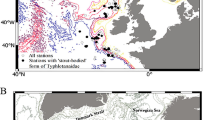Abstract
LAST month, when in the Mansa Valley, Honolulu, Hawaiian Islands, I became acquainted with the large slug which is now common in that locality. A living specimen was handed to me by Dr. Robert Faus, and later Dr. Montague Cooke gave me a good series from the collection of the Bishop Museum. Until recent years these slugs were unknown in the islands, and no doubt remained that they had been introduced. Nevertheless, as Dr. Cooke informed me, no one knew whence they came, or what (if any) described species they represented. I find that they agree with Veronicella Jeydigi, described from specimens collected at Brisbane, Queensland. Simroth, who made the species known, gave good coloured figures, and figured the anatomy. Henry Tryon (1899) gave a popular account of the slug, showing that it was destructive in gardens. Both he and C. Hedley were of the opinion that the animal had been introduced from some unknown locality. Dr. Willey lound specimens at Esafate, Newr Hebrides, and this may be the original home.
This is a preview of subscription content, access via your institution
Access options
Subscribe to this journal
Receive 51 print issues and online access
$199.00 per year
only $3.90 per issue
Buy this article
- Purchase on Springer Link
- Instant access to full article PDF
Prices may be subject to local taxes which are calculated during checkout
Similar content being viewed by others
Author information
Authors and Affiliations
Rights and permissions
About this article
Cite this article
COCKERELL, T. The Large Black Slug at Honolulu. Nature 114, 502–503 (1924). https://doi.org/10.1038/114502c0
Issue Date:
DOI: https://doi.org/10.1038/114502c0
Comments
By submitting a comment you agree to abide by our Terms and Community Guidelines. If you find something abusive or that does not comply with our terms or guidelines please flag it as inappropriate.



